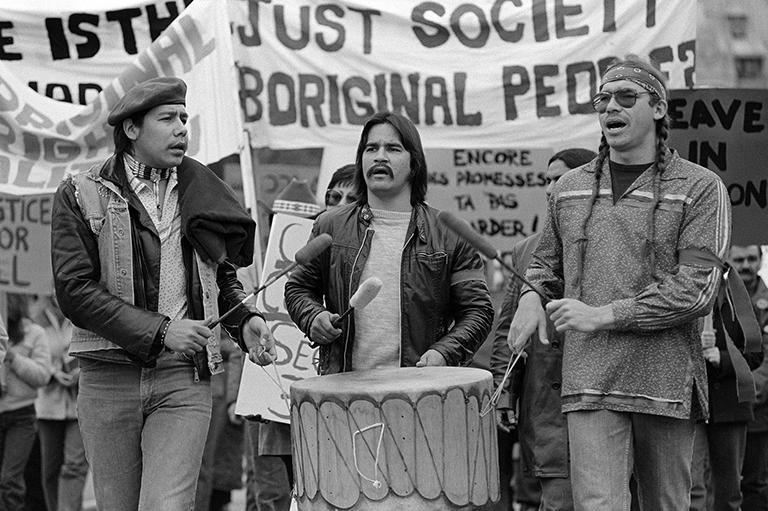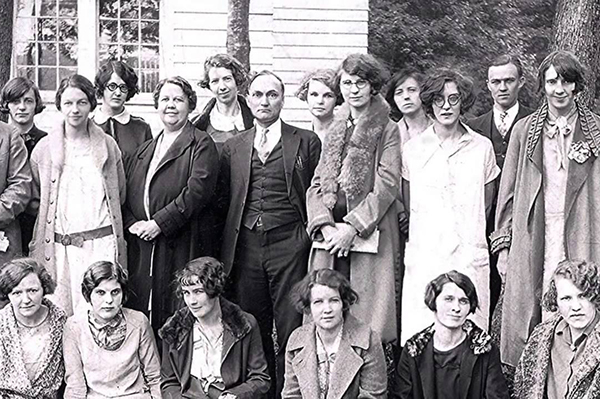Understanding the Canadian Charter of Rights and Freedoms
Grade Levels: 9/10, 11/12
Subject Area: Social Studies/History/English/French/English Civics
This lesson is inspired by the Rights and Freedoms issue of Kayak: Canada’s History Magazine for Kids.
Lesson Overview
The purpose of this lesson is to work on characterizing an event in Quebec and Canadian history. Students will trace the important events leading up to the patriation of the Canadian Constitution, through the “Night of the Long Knives,” the 1980 referendum, and the creation of the Canadian Charter of Rights and Freedoms. They will be able to establish the facts and timeline of these events. They will identify the actions of those individuals and groups who played an important role in the creation of the Canadian Charter in a scripted representation of the timeline of events, or by creating a group cartoon. They will be asked to analyze the sections of the Charter by creating an infographic that summarizes one category of rights. When put together, these infographics will provide a better understanding of the sections of the Charter. As part of the analysis, they will be able to compare the sections of the Canadian Charter of Rights and Freedoms with the Quebec Charter of Human Rights and Freedoms. At the end of the lesson, they will be able to interpret a current issue related to the secular nature of the state and the Quebec Charter.
Background Information
This lesson deals with an important topic in Canadian and Quebec history that often surfaces during election periods. The political climate in Quebec has become tense following the 1980 referendum, in which the result did not allow for Quebec sovereignty. Pierre Elliott Trudeau, Prime Minister at the time, had wanted for months to patriate the Canadian Constitution (to transfer Canada’s constitution from British authority to an independent Canadian Constitution that was amendable by Canada). Some provincial premiers joined forces to present a counterproposal to the federal government to recognize certain specific rights, such as the right to withdraw from certain decisions, with financial compensation. It was during the night of November 4-5, 1981, that the dissenting provinces, without Quebec, agreed on the clauses of the Constitution and signed the federal demands. These events led to the creation of the Canadian Charter of Rights and Freedoms, which did not recognize the distinct society status requested by René Lévesque, then Premier of Quebec.
The provincial parliament of Quebec had already passed the Charter of Human Rights and Freedoms on June 27, 1975, which ensured that all Quebecers would be treated equally and without discrimination or exclusion. However, the Canadian Charter of Rights and Freedoms takes precedence over the latter.
Recent litigation is underway between the provincial and federal governments over the legitimacy of Bill 21 on the secular nature of the state. This debate is still ongoing.
Lesson Activity
Part 1: Introduction and Knowledge Activation
Introduce the text: Quebec has its own approach and its own Charter.
Discuss a fact that has been present in Quebec politics for hundreds of years: distinct society. Ask questions to determine what students know, or benchmark, in relation to this statement and activate students’ prior knowledge on the topic.
Sample questions include:
- What is a referendum?
- Why does the Quebec government often claim that Quebec is a distinct society from the rest of Canada?
- What is the “Night of the Long Knives”? (An analogy can be made with the event that occurred before the Second World War in Germany).
- What is a right? Can you name any?
- Do you know any sections of the Canadian Charter of Rights and Freedoms?
- What do you know about Bill 21 and the secularism in Quebec? What does state secularism mean?
- Why do you think René Lévesque mentions in the text: “Quebec is on its own”?
By reading the text first-hand, the student is led to see the author's position and must determine why he or she adopts this position. To do this, they must have knowledge of the subject, which is why, in the next activities, they will be led to learn about the events related to the text.
Part 2: Setting the Context
Prepare students to identify the important events that took place between the Quebec government of René Lévesque and the patriation of the Canadian Constitution by Pierre Elliott Trudeau between 1975 and 1982. You may wish to have students make a timeline of the events.
Here are some suggested events (Source: Sheppard, R. [2012]):
- Canadian Bill of Rights 1960
- Election of Pierre Elliott Trudeau as Prime Minister of Canada and his desire to patriate the Canadian Constitution
- Quebec referendum in 1980
- Talks to draft the Canadian Charter of Rights and Freedoms
- The tour of the provinces by Jean Chrétien, Minister of Justice
- First Ministers’ Conference in September 1980
- Release of the so-called “Kirby Memorandum”
- The process of requesting the Liberals to speed up the adoption of the constitutional resolution
- Strong opposition from Joe Clark’s Conservatives
- Ontario and New Brunswick premiers support Trudeau Liberals
- Band of Eight rallies
- Last chance conference at the Chateau Laurier in Ottawa
- “The Kitchen Accord”
- The “Night of the Long Knives”
- René Lévesque does not sign the agreement and asks for a referendum by Ottawa
- New rights are added by women’s and Indigenous groups
- Approval of the Constitution by the British Parliament
- Queen Elizabeth II's visit to Canada for the signing of the new Constitution Act on April 17, 1982
- The Meetch Lake Accord in 1987
- The Charlottetown Accord in 1992
- 1995 referendum
It is also important to understand who the actors were and to describe the political context of the time. This can be done by presenting the federal and provincial political context. Students can do short research on characters or groups that played a role in these events, such as:
- Pierre Elliott Trudeau representing the federal position
- Jean Chrétien, Minister of Justice for the federal government
- René Lévesque, Prime Minister of Quebec
- The “Group of Eight”
- The Government of Ontario
- The Government of New Brunswick
- Joe Clark, leader of the Conservative Party of Canada
You can use textbooks or sites such as the Canadian Encyclopedia to obtain a list of important events, as well as the proposals of each group.
Sheppard, R. (2012). “Patriation of the Constitution.” The Canadian Encyclopedia.
Part 3: Taking Action!
At this point, students will build out the timeline of events by further studying the people that contributed to and the moments that led to the creation of the Canadian Charter of Rights and Freedoms. Divide the class into groups. Assign or have students choose an actor or a group of politicians from among those presented earlier. Students research the role their actor or group played in the events leading up to the patriation of the Canadian Constitution through the “Night of the Long Knives.” They may also determine and attempt to explain their political position in the events. Students should record their information on a sheet of paper that is later submitted for evaluation.
Option A:
Students can act out the events in the order in which they occurred. This type of activity develops historical empathy and reinforces a sequence of important historical events. Remind students that they are the narrator and will need to connect the events by mentioning or explaining important facts.
Option B:
Students can create a comic strip that chronologically illustrates the events surrounding the creation of the Canadian Charter of Rights and Freedoms. While researching the actors or groups involved in the events, students can illustrate these people and moments. This can be done by hand, or with the help of various comic book creation software. Through their creation of a timeline of events, you will be able to assess whether students are able to place historical events in time. Using their research notes, you should be able to determine if students accurately represented the events, the actors, and their postitions. This activity incorporates interpretation and historical perspectives. In particular, it will shed light on the opposing points of view going into Charter negotiations and the ways in which there was eventually agreement in all provinces except Quebec.
Part 4: Analysis
Divide the class into seven groups so that each group must analyze one category of the Canadian Charter of Rights and Freedoms. They must summarize their category by highlighting three important elements. You can share the categories of the Canadian Charter of Rights and Freedoms by creating a collective infographic summarizing each part of the document. Each team can then present their understanding of their category in a short presentation to the other students. Through this activity, they will learn about the rights granted in Canada.
Here is the list of categories:
- Fundamental Freedoms
- Democratic Rights
- Mobility Rights
- Legal Rights
- Equality Rights
- Official Languages of Canada
- Minority Language Educational Rights
See the Canadian Charter, official document. Summary of the Charter categories.
Part 5: Conclusion
Explain the section of Bill 21 of the Quebec Charter of Human Rights and Freedoms.
-
Additional information: Publications Québec (2022). LégisQuébec. Act respecting the laicity of the State.
Summary of Bill 21 on the Secularism of the State.
-
Government of Quebec (2022). À propos de la Loi sur la laïcité de l'État.
Back to text: Quebec has its own approach and its own Charter. Reread the text with the students and review the important elements. Ask the students to come back to René Lévesque's statement: “Quebec finds itself all alone.”
Ask the following questions to the students:
- Can you explain why René Lévesque, the Premier of Quebec, said this sentence?
- What is the Canadian Charter of Rights and Freedoms?
- Explain why such a document is necessary in a state?
- Do you think that other articles of law could be added to the Charter? Explain your answer.
Supplemental Charter Activities
-
Library of Parliament (2021). Our Country, Our Parliament: An Introduction to how Canada’s Parliament work. pp. 11-12.
Themes associated with this article
Advertisement




